Disclaimer: What follows is my personal take on these announcements, all of these assumptions and predictions were made based on the webinar itself and my experience with the platform. We will see how accurate those are in a few months I guess.
Unless you spent the last few weeks under a rock, you will have seen that Tableau announced on Friday what they called “The Future of Tableau.”
What it was communicated as was very much an evolution of the fourth wave section of this year’s Tableau Conference keynote, which I summarised and put into context in a blogpost as well.
The one thing that stood out for me was that Tableau moves more and more from being a tool that helps people “see and understand data” to being a platform that handles your data throughout our organisation and that lets you take action on your data. Integrations with Slack, Salesforce, SAP and Oracle where mentioned or demoed. I appreciate the focus on “taking action”, this was something I had prominently featured in my talk at TC23, so I’m quite happy to see that somebody from the executive team clearly must have sat in the audience.
In general, many of these features also seem to cater to “non-data people,” i.e. business users and managers who just want to get an answer to their question and get on with their day. Data Analysts and Engineers will certainly not be out of a job; the focus of the work might be shifting from “creating dashboards” to “creating independent assets that can be used throughout the platform.”
For a more detailed discussion of the webinar, I recommend Tableau Tim’s podcast with Ravi Mistry.
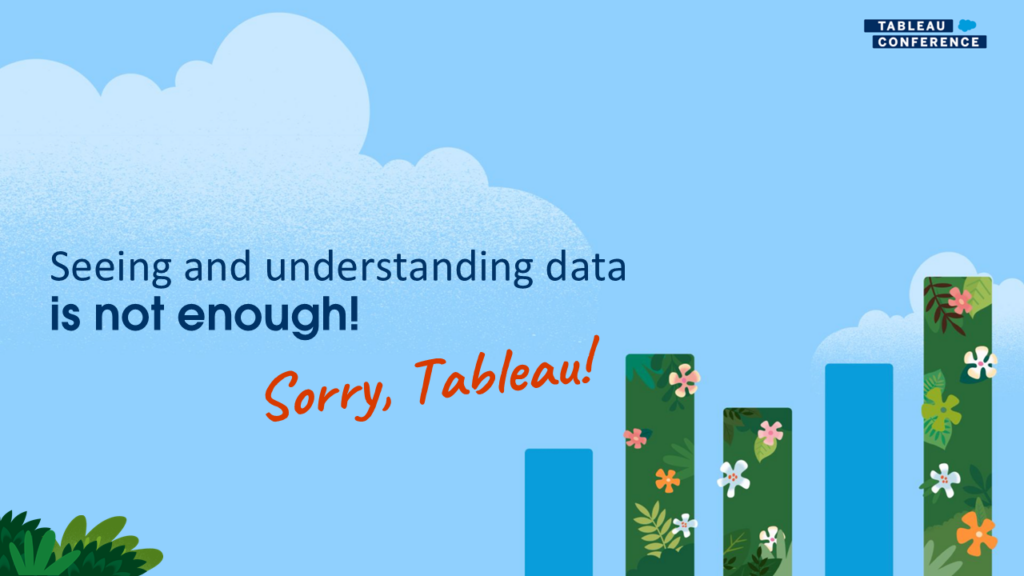
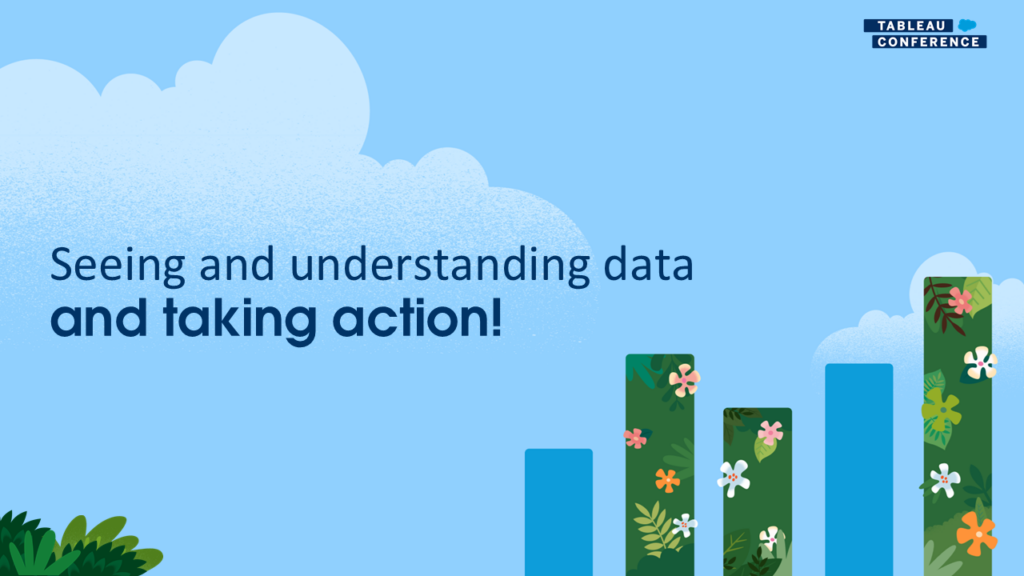
The demo and announcements were a lot more concrete and tangible than at Tableau Conference in May and confirmed a lot of the assumptions from earlier in the year.
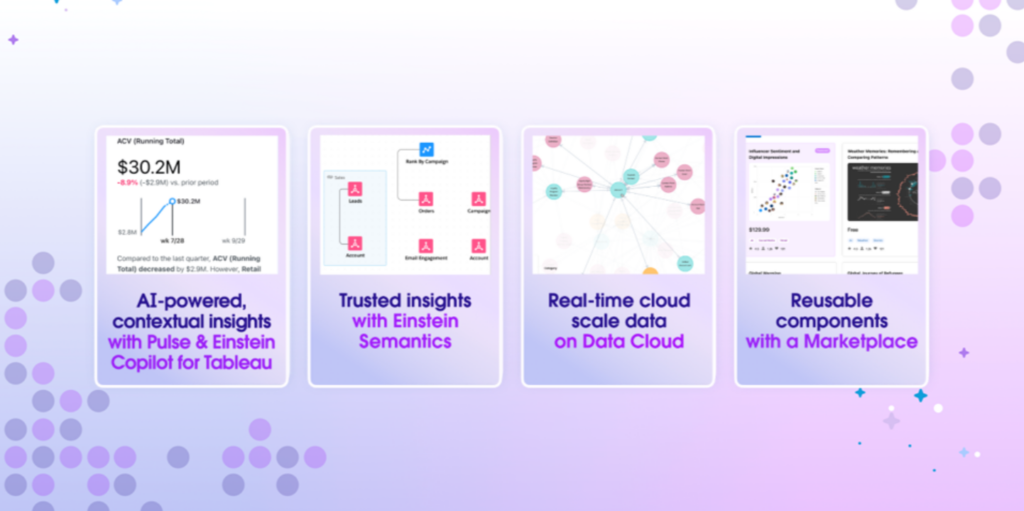
The most obvious feature for everybody to see was the shift to the Salesforce design system. It makes sense from a strategic point of view, but it does come with all the common problems with a shift in design, like comparisons against the old one, clash with personal preferences, etc. Personally, I am very much in favour of this change. The old design was based on the Desktop App, which is around 20 years old, and even the UI revamp with Tableau 10 around 2015 is nearly 10 years ago. A refresh was long overdue and I really hope it comes with a lot of UX improvements!
In this particular case, however, it also raises additional questions and concerns from the existing user base (“Does Tableau become Salesforce?”, “Will I need Salesforce to be able to use those features”). At this point I just want to point out that Tableau became Salesforce 5 years ago and that all Tableau users are – by definition – Salesforce users.
Tableau keeps emphasising that these features are not dependent on being a core Salesforce user (Sales Cloud, Service Cloud, etc.) and I am not really concerned about it; making it Salesforce-only would alienate a huge part of their user base; I am really curious about the licensing though! So – based on the demos seen so far – this looks like Salesforce but it is separate to “Salesforce” as a product (again, Sales Cloud, Service Cloud, etc.). When you buy it, you’ll likely have a Data Cloud org which seems to sit underneath all of this, but apart from this you should be able to use most (if not all) of these features without any of the other Salesforce products.
The Future of the Interface
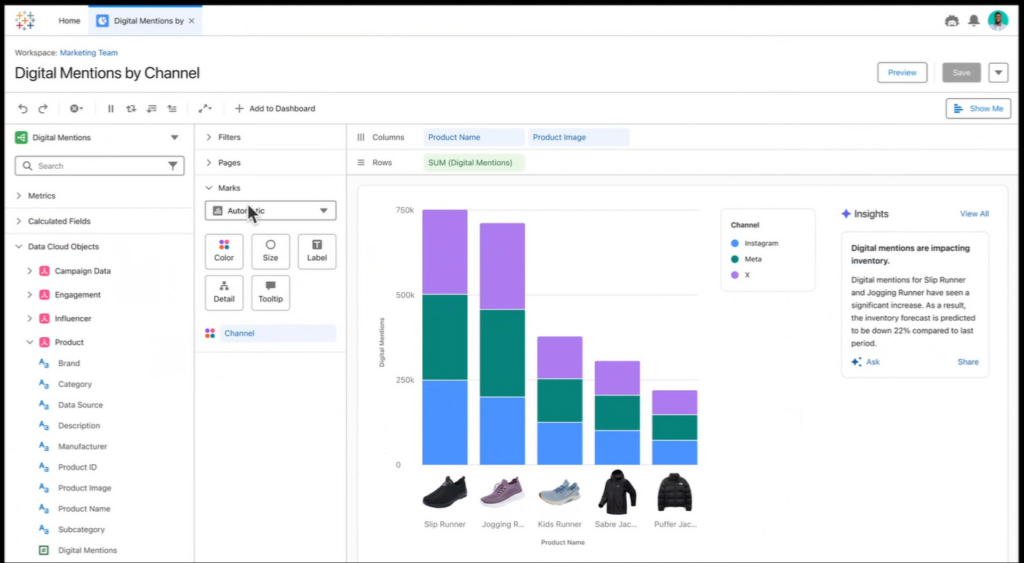
Purely based on the interface on screen I have a few educated guesses what that might mean for “the Future of Tableau”:
- All new features use the Salesforce design system (Pulse did that already and it sticks out like a sore thumb on Tableau Cloud for now). I expect this to continue and – sooner or later – to replace the existing interface.
- They showed the existing developer interface with Salesforce design. Based on the visible features, it seems to be a new interface/experience rather than “just” a reskin of the existing tools. My hope is that this was done in a way that is extensible in the future, achieving parity with the current interface and eventually with Tableau Desktop.
- The talk about the marketplace in combination with the new design may point into the direction of major changes as well. You need to have a suitable architecture in place to export and import charts into dashboards and I would assume that the current architecture wouldn’t really support it.
- If this is the case, this could also lay the foundation for other features that cannot feasible developed with the current architecture (the container approach to dashboards, the Formatting options or even collaborative features)
- This will also mean existing Salesforce users will get a Salesforce-native Tableau experience and a huge improvement on any current analytics features in the platform (looking at a very makeshift integration of CRMA into Salesforce)
- Most, if not all elements, seem to be “composable” (Thanks to Tim Ngwena for that term); ie. they can be reused and embedded in different contexts (dashboards, apps, websites, Salesforce lightning pages, etc.)
Apart from a Tableau re-design in the future, the “convergence of Tableau and CRMA” also confirmed my assumption that CRMA – as it exists today – will become a legacy tool. There is no question that Salesforce will keep it alive for the foreseeable future but I would expect it to shift significantly, from being a dashboarding tool to being a technical enabler for Tableau Einstein. For me this is the only logical conclusion.
Some other notable features where:
- the action framework which, in a much more rudimentary form, currently exists in CRMA and allows you to literally take action on your data. Great concept in theory; this means you will need to anticipate the actions that can be taken and develop an integration for them. This is not a problem per-se, but something to keep in mind when the sales-pitch is “You can easily take action on your data”
- The “marketplace” to share analytical apps. The likes of Salesforce and Snowflake have had this for years, and I can see potential in it – especially for internal purposes. As a public marketplace, I can see the appeal but also the challenges of it being properly managed (think IP, plagiarism, administration, monetisation, etc.)
- references to data streaming which would be a cool feature and actually allow real-time insights into processes
There was also a throw-away comment made on a new Tableau Prep experience which will be announced at Dreamforce. This was the first time I have heard of it but my expectation would be a similar re-design as well as maybe a merge with existing Salesforce recipes and dataflows. Again, these Salesforce features were and are a pain to work with and currently directly compete with Tableau Prep. Delivering one tool that can serve all of these use cases makes sense.
What to expect of Tableau Einstein?
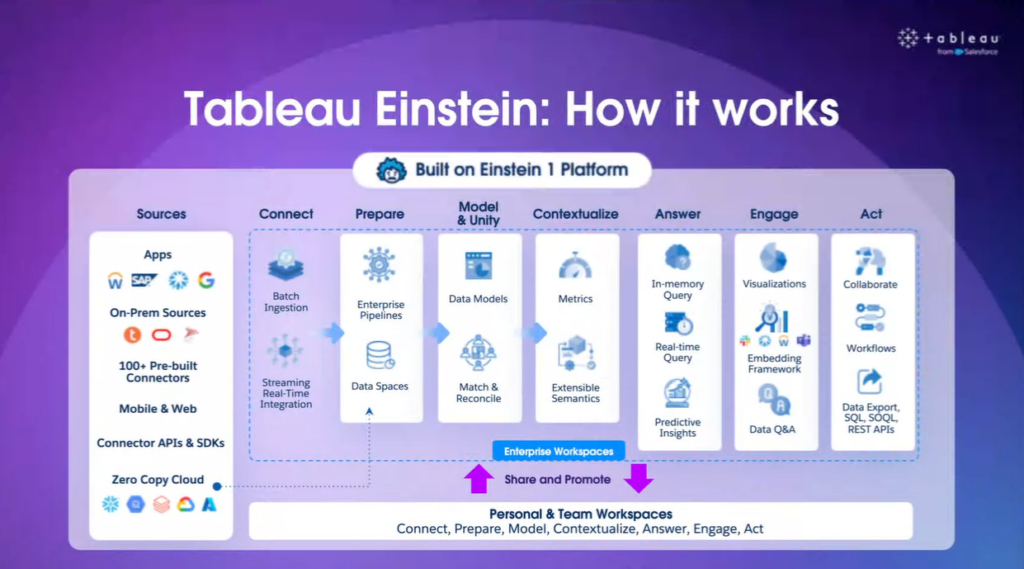
More products, more names, just after the announcement of Tableau+!
All these new features were presented as “Tableau Einstein” but this doesn’t mean anything. Salesforce is notoriously indecisive with their naming and regularly rebrands existing features, causing a lot of confusion; I would not be surprised if all of this changes before Tableau Conference 2025.
In general, this looks like a good value proposition for customers; it allows you to do a whole lot more with more data and more connected systems. This new architecture, built on Data Cloud, raises important questions around products, licensing and compatibility though.
Unsurprisingly, there was no mention of pricing and licensing and even timelines. We don’t know how close to a finished product this is and how this can be enabled – if at all – for existing customers on existing deployments.
Personally, with the apparent changes in features and approach I am convinced that these features can be rolled out on the current Tableau Server and Cloud architecture. Based on the demo, there are too many new features that require a very different approach to data to be just an extension of the current platform. I’m happy to be proven wrong on it but if this will be available to Tableau Cloud customers, Tableau would be well advised to make that as clear as possible, as soon as possible. As with most of the recent, big features, I’d expect very few, if any, of these to become available to Tableau Server customers; which is in line with Salesforces Cloud native approach.
Architecture wise it might be able to sit “on top of” Tableau cloud, so that you may be able to use this new experience to access current Tableau assets but beyond that there isn’t really enough detail to understand how existing customers will integrate those new capabilities.
The Future of the Product?
One thing I hadn’t thought about in these terms before, is the fact that Tableau started off as an analyst tool to replace written SQL queries with an easy drag and drop interface and create some good looking charts. This positioning evolved significantly, arguably already before the Salesforce acquisition, to a tool that gives an organisation a more comprehensive way to “work with data”, which includes governance, semantic layers and an action framework, which targets all types of roles within and outside of an organisation. This has been going on for a while with the Embedded licensing model and the VizQL APIs and what was shown today takes it a step further to integrate other organisational systems like a CRM (no surprise here) and ERPs (which – to a degree – Salesforce can be used for as well).
I don’t think the core developer experience will go away, but I do think this is, for a while now, just one aspect to the overall value proposition. Personally and egotistically, I prefer the “old way” where 100% of the effort was dedicated to solving “my” (read: the analysts) problems. Realistically though I do understand that this is probably not enough to make a living in the long-run. Professionally, I am quite curious to see these features implemented and explore the possibilities they offer; they certainly address use-cases that most of us are familiar with, so the main question becomes how feasible is the implementation and at what cost?
Speaking as a part of the wider Tableau community, we will have to acknowledge and come to terms with that fact that – while new releases used to have 100% new features for analysts – there is now a need to cater for a much broader audience and only part of the new features will be targeted at “us”. I believe this would have been the case with the acquisition and without it. There will always be pushback along the lines of “I have been using Tableau for years and I don’t like this new stuff” and in most cases this will come from a genuine place of concern but the reality is – unfortunately – that building and selling a specialised tool pays the bill only for that long.
You can of course criticise Tableau for not acting like they used to but it might be more productive to accept that change affects everybody and make peace with the fact that strategic directions shift for a lot of different reasons. The reality is that only a very small amount of people are involved in those kind of strategic decisions and in most cases they are not shared in detail with the public.
Do you think there is anything I missed or have grossly misrepresented or misinterpreted?
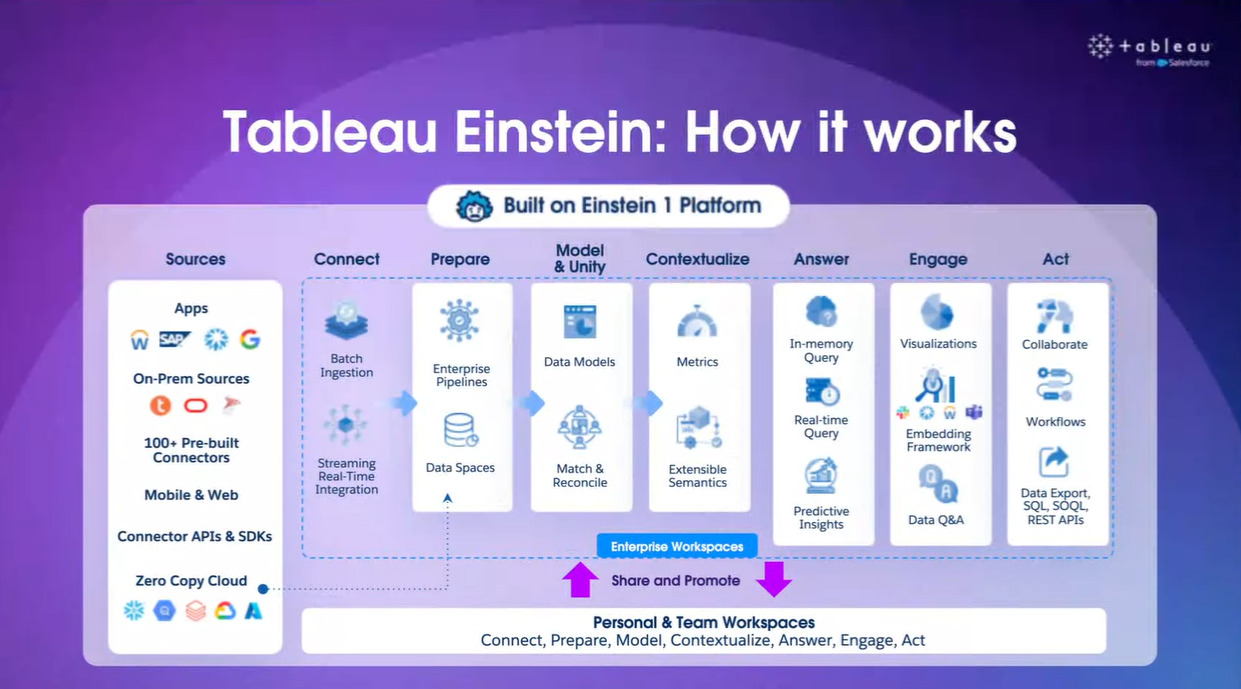
Leave a Reply